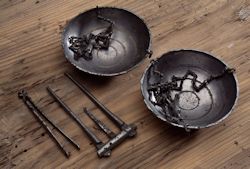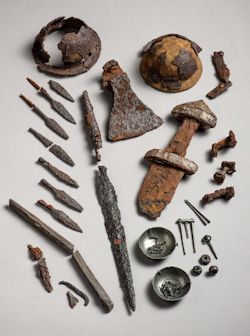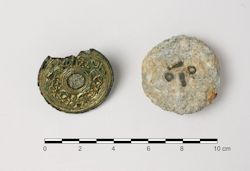
From Trøndelag, 12 burials are known containing remains of balance scales and weights. Balance scales most commonly occur in men's graves, of both the 9th and 10th centuries. In Trøndelag nine examples are known from male burials, while only two such items have been recovered from women's graves (Heen-Pettersen 2013, 56-57). Burial of unburnt bodies seem to have been the prevailing custom in Trøndelag for those with Insular weighing equipment, and in at least six cases, the body was placed in a boat covered with a mound. Several of these locations stand out because of their particularly rich grave-furniture, emphasising the buried person's importance within their families and communities (Herstad 2012). Associated grave goods include various types of weapons, e.g. high-quality swords with silver decorated handles; two examples from Haug, Verdal, and Gravråk, Melhus, which have Ulfberht inscriptions on the blade; personal jewellery of silver, glass, amber and carnelian, in addition to various types of tools and equipment, e.g. whetstones, blacksmiths' equipment and sickles (Herstad 2012, 101).
Several researchers have claimed that most of the scales found in Norway may be of Insular origin, based on their decoration and design (e.g. Jondell 1974; Petersen 1940). The fact that several of the graves also contained other artefacts of Insular origin may support this assumption. Sometimes combined with bronze boxes and lead weights, the scales have often been associated with traders and generally interpreted as evidence of Norse trading activities in the western world. However, it has also been suggested that such weighing equipment may have been necessary for accurate loot-sharing (Wamers 1998, 43). Their small size suggests the weighing of valuable commodities. During the Viking period, this might have principally been silver, whether coins, ingots or hacksilver (Gaimster 1991). Within the Trondheimsfjord area, balance scales are found at nearly every place where marked concentrations of Insular material occur. It is, however, noticeable that in most cases only one burial within each of these areas contained such weighing equipment. This suggests that trading, or other activities involving the weighing of small, valuable products, was concentrated in only a few persons or families within each community.

A particular well-preserved balance scale from Trøndelag was found in 2003 during an excavation at Lø, Steinkjer (Figure 10). Here a richly furnished male inhumation of AD c. 900-950 was discovered, placed within a 9.5m long boat that had been dug into the top of an older barrow (Grønnesby and Ellingsen 2012, 21). This is in fact the most recent grave containing Insular artefacts to be discovered in mid-Norway. The grave goods in the Lø burial included a complete set of weapons, a ring-headed pin, some tools and personal items, in addition to the balance scale of tin-coated bronze, which had been put in a small wooden box before being placed by the feet of the man (Figure 11). The set of scales comprises two bowls, each of which is suspended on three wire chains, which are drawn together towards the point where they are attached to a spacer. Above each spacer there is a further length of chain that joins with the balance bar of the scale. Each bowl measures 65mm in diameter and is decorated with delicately engraved geometrical designs and a rosette ornament on the inside of the base. The decoration has penetrated through the shiny tin coating to reveal the contrasting yellow copper alloy underneath (Skinner 2012, 120-1). Based on the tin-coated bronze, the design and decorations of the arms, chain and scales, Geir Grønnesby and Ellen Ellingsen (2012, 34-35) have classed the scale from Lø as a Steuer type 2 and believe that this particularly example is likely to be of Insular origin. This type of scale is generally placed in the 10th century, and they are only found in Norway, Ireland and Scotland (Steuer 1997, 237).

Weights are not uncommon finds from the Viking Age in Norway, and are sometimes found with accompanying scales, but from Sør-Trøndelag, there are two examples from Tønnøl, Bjugn, and Solstad, Skaun, of particular note. They are made of small, Insular decorative mounts, which have been turned into weights. The weights appear somewhat different in shape, size and weight. The example from Solstad, which represents a stray find, measures 43mm in diameter with a weight of 182.4g (Figure 12). It had, however, slightly disintegrated when found and the original weight is therefore uncertain (according to finds information in the museum catalogue). The weight from Tønnøl has a conical shape and appears complete, but weighs only 24.2g. It was found together with another lead weight, both of which had been placed inside the bowl of a balance scale when discovered in a male boat-burial, dated to the 10th century (according to finds information in the museum catalogue). In addition to the examples from Trøndelag, such weights are known from at least eight other sites in Norway, including a female burial at Hopperstad in western Norway, which is one of the richest female Viking graves from western Norway (Sørheim 2011, 17). These weights, which originally formed part of prestigious church objects, ended up in Viking society where their function was somewhat different from their original purpose.

Internet Archaeology is an open access journal based in the Department of Archaeology, University of York. Except where otherwise noted, content from this work may be used under the terms of the Creative Commons Attribution 3.0 (CC BY) Unported licence, which permits unrestricted use, distribution, and reproduction in any medium, provided that attribution to the author(s), the title of the work, the Internet Archaeology journal and the relevant URL/DOI are given.
Terms and Conditions | Legal Statements | Privacy Policy | Cookies Policy | Citing Internet Archaeology
Internet Archaeology content is preserved for the long term with the Archaeology Data Service. Help sustain and support open access publication by donating to our Open Access Archaeology Fund.
File last updated: Wed Dec 3 2014